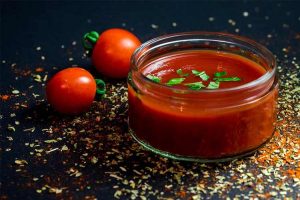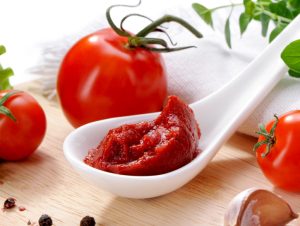Tomato paste, a popular sauce used in the making of almost all dishes in many cultures, is introduced to the market in various packings and forms, such as in cans and squeeze tubes. Essentially, tomato paste is a super concentrated type of tomato sauce. Tomato paste either canned or packed in a squeeze tube is a thick paste made by boiling tomatoes for a few hours to lower the water content, washing the seeds and skins, then boiling the water to make the basis thick and rich concentration. What’s more, the rising market for tomato paste has given rise to new varieties of the product, each with its unique manufacturing or packaging method, providing a variety of purposes and needs for customers. The skins and seeds are separated in the production of tomato paste, tomato sauce, and tomato juice, and this combined fraction, known as pomace or pulp in different regions of the world, has been used as cattle feed. The pulp, as it’s known in Europe, contains a lot of protein and fat, but it’s also somewhat fibrous.

The presence of 15% oil, however, significantly increases the digestible energy value of this material. Tomato seeds are separated from the remainder of the co-product, and an oil rich in unsaturated fatty acids is extracted. The extraction produces a high-protein tomato seed cake, which is regarded as a high-quality meal. The finished products are then packed in different sized cans with citric acid preservation or squeeze tubes with salt preservation.
The difference between canned tomato paste and tomato paste in a squeeze tube
The ever-increasing demand for tomato paste, along with the fact that canned tomato paste is prone to molding over time, has necessitated the development of an alternate tomato paste packaging for people with less demanding consumption needs. Tubed tomato paste is a practical alternative to canned tomato paste since it allows you to use only what you need without having to worry about wasting the rest of the can. It’s manufactured in the same way as a canned paste but comes in a squeezable tube with a screw cap to keep the tomato paste fresher for longer. The tomato paste tubes have a smaller capacity than the canned tomato pastes, but they can keep the tomato paste for longer. There are some significant distinctions between canned tomato paste and tomato paste in a tube, as it turns out. To begin, the cans are all preserved with citric acid (rather than salt), so the paste is slightly tangy but still flat. The tubes, on the other hand, are preserved using salt rather than citric acid, which gives them a saltier flavor. Even though the labels all said “twice concentrated,” the canned pastes were thicker and darker in texture and appearance than the paste in tubes, which was softer and looser. (This simply means that the pastes are placed in evaporation tanks after cooking to remove excess water and concentrate the taste.) It doesn’t imply that they’re twice as flavorful as the cans.) The difference is most likely due to the way the pastes are prepared. Because most American food manufacturers are prepared to preserve food in cans rather than tubes, tubes of tomato paste are almost always imported from Italy. Italy prepares tomato paste in a unique way. The paste is prepared to 150 degrees instead of the normal 200 degrees in the United States. “A greater temperature darkens and caramelizes the paste while also deactivating enzymes that would ordinarily break down the fruit’s firming pectin, resulting in a thicker paste.” The cold-break method produces a paste that is looser, brighter crimson, and fresher-tasting due to the lower temperature.”

Nutrients of tomato paste
Tomatoes have moderate to high levels of vitamin C, vitamin A (as provitamin A), folate, and potassium, among other nutrients (17). Tomatoes have a dry matter content that ranges between 5% and 10%. Solids account for three-quarters of the dry matter in mature tomatoes, with sugars (50 percent), organic acids (>10 percent), minerals (8%), and pectin (7%). (18). The principal sugars present are glucose and fructose, while additional sugars such as raffinose, arabinose, xylose, galactose, and sugar alcohol, myoinositol, have been found in low amounts. Tomatoes have a large number of carotenoids, which are beneficial substances. Tomatoes include two types of carotenoids: nonoxygenated carotenes including lycopene, -carotene, -carotene, -carotene, phytoene, phytofluene, and neurosporene, and oxygen-containing xanthophylls like lutein, zeathanxin, neoxanthin, and canthaxanthin. Lycopene (60–90 percent of total carotenoid per weight basis) is the most abundant carotenoid in tomatoes, followed by phytoene (5.6–12 percent), -carotene (1–11 percent), neurosporene (0–9 percent), phytofluene (2–5 percent), -carotene (1–5 percent), and lutein (0.1–1 percent), with trace amounts (1%) of other carotenoids (20–24). The forms of provitamin A that can be turned into vitamin A in the human body are -carotene, -carotene, and -cryptoxanthin, among the carotenoids in tomatoes. Carotenoids in tomatoes vary greatly in terms of their kinds and concentrations. Carotenoids in tomatoes come in a wide range of types and amounts, depending on cultivars, maturity stage, environmental factors, and growing conditions (25). In tomatoes, lycopene and other carotenoids are mostly found in the all-trans configuration (also known as all-E-isomers) (24, 26). Carotenoids in the cis-forms (Z-isomers) appear naturally in tomatoes, including 5-cis, 9-cis, 13-cis, and 15-cis lycopene (27). Their percentages are determined by the cultivars and are heavily influenced by the maturity stage. According to one study, the percentage of cis-forms of lycopene ranged from 0–8.83 percent for one variety to 0–14.22 percent for another variety as they progressed from green to red (28). Flavonoids and phenolic acids are found in abundance in tomatoes. Raw tomatoes include significant flavonoids such as rutin (quercetin-3-O-rutinoside), naringenin chalcone, and quercetin. Tomatoes contain naringenin, myricetin, kaempferol, and their glycosides, albeit in low amounts. The primary phenolic acids in tomatoes include hydroxycinnamic acids, such as chlorogenic and caffeic acids, and chlorogenic acid derivatives, such as 5-caffeoylquinic acid, 4-caffeoylquinic acid, and 3,4-dicaffeoylquinic acid. Tomatoes also included minor phenolic acids, such as p-coumaric and ferulic acids, as well as their glucosides (22, 29, 30). The types and amounts of phenolic chemicals in tomatoes, like carotenoids, differed greatly depending on cultivars, maturity stage, environmental factors, and growing conditions (28, 30).

Moisture, and total and soluble solids are all different in fresh tomatoes and processed tomato products. Most fresh processed tomatoes, for example, contain about 5–6% soluble solids (49), whereas tomato paste might contain up to 80% soluble solids. Moisture, total and soluble solids, and total and soluble solids are all different in fresh tomatoes and processed tomato products. Most fresh processed tomatoes, for example, have about 5–6% soluble solids (49), whereas tomato paste might have anywhere from 20% to 37% soluble solids, depending on the manufacturing requirements (44). To understand the genuine changes, comparisons between data given on a dry weight basis must be done to adjust for moisture changes (50).
Data on the effects of industrial processing on carotenoids is currently inconclusive and occasionally contradictory. Lycopene levels increased in two experiments, decreased in two studies, and remained unchanged in four research when tomatoes were processed into paste. According to one study, the concentration of lycopene in tomato product (paste) could increase or decrease depending on the degree Brix (oBx; the degree Brix is defined as the sugar content of an aqueous solution, and it is also the most common scale for measuring soluble solids in the food industry) (45). However, five out of six investigations on -carotene found that it reduced after industrial processing, and only one found no change (Table 1). The data mismatch can be explained as the following:
- Carotenoids come in a variety of forms. The chemical structures of carotenoids and their placements in the cell compartment of uncooked tomatoes determine their heat stability. The linear all-trans form of lycopene, for example, combines into crystalline structures within chromoplasts in raw tomatoes, giving lycopene better thermal stability (51), whereas -carotene appeared to be less robust to heat treatment (52).
- Method and conditions of processing Carotenoids in tomato products are greatly influenced by the processing method and conditions (time, temperature, peeling procedure, etc.). Increased losses are often associated with higher processing temperatures and longer processing durations. According to one study, lycopene levels varied depending on the processing conditions: higher levels were discovered in 10 oBx tomato paste, while lower levels were found in 15 oBx tomato paste (46).
- Tomato varieties. Different cultivars of processing tomatoes have different nutrient levels, soluble solids, and titratable acidity, all of which might affect the outcome of available/releasable nutrients and dietary components following processing. It was discovered that tomatoes with higher levels of soluble solids and titratable acidity are better for making tomato paste because they require less thermal treatment and so lose fewer nutrients (18, 49). Another noteworthy discovery was that while industrial processing had no effect on the quantity of -carotene in red tomatoes, it drastically reduced it in yellow tomatoes (39).
- Growing circumstances and other environmental factors may affect the chemo-physical qualities of tomatoes, affecting the amount of carotenoids in finished tomato products. Takeoka et al. (42) discovered that the oBx of fresh processing tomatoes changed from year to year when obtained from the same locations. In fact, the oBx was 5.4 in 1998 and 4.9 in 1999 for the same variety of tomatoes processed in the same plant. In 1998, there was no significant loss of lycopene due to paste processing, but there was a 28 percent loss in 1999. The higher loss in 1999 was attributed to the slightly lower Brix level of the fresh tomatoes, which necessitated a longer processing time to produce the paste’s ultimate Brix value.

The difference between tomato paste and tomato sauce
The consistency is perhaps one of the most visible distinctions between tomato sauce and paste.
Because tomato paste contains more tomato solids, it has a lower water content than tomato sauce. Because the tomatoes are simmered for a long period until the water content is emptied from them, the way they are cooked affects their consistency.
Because tomato sauce contains more water than paste, it is significantly more liquid. Tomato paste has the thickest consistency of all tomato-based condiments, whereas tomato sauce has the lightest and thinnest consistency.
The taste
Because tomato paste has fewer components and a higher tomato content, it tastes a lot like dried tomatoes.
Because tomato paste has such a strong flavor, it doesn’t need to be used in such large quantities in meals; a little goes a long way.
Tomato sauce, on the other hand, tastes almost identical to fresh tomatoes, despite the fact that it is usually consumed prepared. Because tomato sauce includes more water than paste, it lacks the concentrated flavor of paste and is usually seasoned to add flavor.
How to use
Tomato sauce can be used in almost any meal that needs a punch of flavor. It’s typically used as a base ingredient in sauces, soups, and stews to thicken, color, and enhance the flavor of other liquid dishes.
Although it may be tempting to toss the paste into your recipe right away, there is a proper way to prepare it that will ensure you get the most flavor out of it.
If you fry the paste, it will become activated and change color. Allowing it to sizzle in a pan with some olive oil or another sort of fat over medium heat will cause it to caramelize, and the color will darken and become less vibrant.
Conclusion
It was claimed that canned tomato paste can mold over time, but this can be easily avoided by utilizing tomato paste in squeeze tubes. The tube holds a significantly smaller amount of tomato paste, making it perfect for people who use it in recipes less often. It also allows the tomato paste to be stored for longer periods of time without molding. Because of the tremendous demand, tomato paste tubes are now available in every supermarket throughout the world.










Your comment submitted.